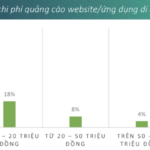A recent Nielsen IQ study on consumer behavior in the digital sphere, with a focus on e-commerce platforms in the Asia-Pacific region, including Vietnam, reveals that today’s consumers have “too many touchpoints in their shopping journey.”
This means they can choose to shop in-store, online via websites, applications, social media, e-commerce platforms like Shopee and Lazada, social commerce, distribution channels, metaverse platforms, or even have their orders delivered directly from warehouses.
THE EVOLVING LANDSCAPE OF E-COMMERCE: A DIVERSE AND CHALLENGING ENVIRONMENT
“Consumers can now view products on TikTok, place orders on Shopee, lodge complaints via Facebook, and return or exchange items at physical stores,” says Le Minh Trang, SMB Associate Director of NielsenIQ Vietnam. “This diverse and ever-changing behavior poses a challenge for businesses in ensuring a consistent customer experience across all touchpoints,” she adds.
Le Thi Ha, Head of the E-commerce Management Department at the Department of E-commerce and Digital Economy under the Ministry of Industry and Trade, also highlights the rapid evolution of consumer behavior. Specifically, consumers are increasingly relying on AI, seeking engaging experiences, and being attracted by entertainment and promotions on e-commerce platforms. According to the survey, 85% of consumers are drawn to the diversity of products, while 71% are enticed by entertaining promotions.
The research estimates that by 2025, approximately 63 million Vietnamese consumers will engage in online shopping, equivalent to 63% of the population. Each consumer is expected to spend an average of $396 per year. Livestreaming is becoming a significant influencer on shopping decisions, with 62% of consumers adopting this format. Notably, consumers are being “led” by AI algorithms and engaging content, resulting in purchases even when there is no actual need.
AI is indeed impacting various aspects of life, and e-commerce is no exception. Emphasizing the role of AI in e-commerce today, Nguyen Ngoc Dung, President of the Vietnam E-commerce Association (VECOM), asserts that for the e-commerce industry, AI is not a question of “whether to use it” but rather “what AI to use” and “how to train it.”
“E-commerce businesses must be pioneers in adopting new technologies,” says the VECOM President. With support from technology companies, AI has become accessible to both large and small enterprises. Mr. Dung mentions that sellers on e-commerce platforms are now utilizing AI in various forms.
According to Nielsen IQ experts, the dynamic changes and complexities of the e-commerce market present operational and growth challenges for businesses. The key lies in consistently winning the hearts of consumers in the context of continuous innovation.
Firstly, businesses need to understand their current position and performance by measuring business metrics and grasping industry and economic contexts to identify potential expansion channels.
Secondly, based on this understanding, they should pinpoint expansion opportunities – from product innovation and channel expansion to enhancing touchpoints and interactions with consumers.
Thirdly, once opportunities are identified and strategies are implemented, businesses must maintain their brand identity and commitment while comprehending consumer psychology, expectations, and concerns. Only then can they foster long-term loyalty and engagement.
This three-pronged model serves as a practical guide for enterprises in their digital transformation journey and e-commerce development.
A DYNAMIC MARKET WITH EMERGING NEW PLAYERS
According to the E-commerce Index Report 2025, Vietnam’s e-commerce market size reached approximately $32 billion in 2024, with a growth rate of 27%. Online retail sales accounted for $22.5 billion, a 30% increase from the previous year. Thus, e-commerce contributed about 12% to the total retail sales of goods and consumer services, higher than the 10% recorded in 2023. The ratio of online goods retail sales to total goods retail sales was 11%, surpassing the corresponding figure of 8.8% in 2023.

Several factors contribute to Vietnam’s high e-commerce growth rate, including a low starting point, high GDP growth, a young population, and the encouragement of online shopping by investors, especially foreign investors, who prioritize market share over profits during this period.
Additionally, the relaxed tax policies for online businesses have meant that many online traders have not had to pay taxes yet. While this has created a form of “tax incentive,” these policies will change fundamentally from 2025, as new regulations require e-commerce platforms to declare and pay taxes on behalf of sellers.
Moreover, Doan Quoc Tam, Head of Cooperation at the Vietnam E-commerce Association, points out that the market will always witness the emergence of new players, leading to continuous competition. For instance, the “Temu phenomenon” recently caused disruptions in the market.
“Cases like Temu are just one example,” says Mr. Tam, referring to the fact that cross-border e-commerce is a global trend, not unique to Vietnam. “As we engage in international trade agreements, new players or businesses testing the market with competitive pricing may emerge,” he adds.
“However, as long as these businesses comply with the law, provide quality products, and satisfy customers, competition will persist, and new entrants will continue to appear. We cannot prohibit or prevent these players, and excessive protectionism is not the solution,” he emphasizes.
Consequently, Vietnam’s e-commerce market is expected to undergo significant changes in the coming years. According to Nguyen Ngoc Dung, President of the Vietnam E-commerce Association (VECOM), the market is witnessing the rise of cross-border business models and digital platforms capable of providing services on a global scale. These models not only break traditional geographical boundaries but also underscore the critical need for close collaboration between nations and domestic management agencies to ensure effective governance and law enforcement.
Additionally, new technologies like artificial intelligence (AI), blockchain, and big data are transforming the entire e-commerce value chain, from advertising and sales to logistics, customer care, complaint handling, and dispute resolution.
In response to these developments, legal policies need to be shaped towards innovation and flexibility, with a business-centric approach that fosters creativity and development while maintaining a balance between economic growth, consumer protection, and digital security.
“Data-Driven Manufacturing is a Must in the New Era”
“Sharing data and expertise among businesses is the fastest way to integrate technology into the production process, fostering a culture of mutual learning. Data is not only an open resource but also a valuable asset for any enterprise. “
Revolutionizing Retail Management: The Digital Transformation Imperative for Savvy Store Owners
In the evolving world of cashless payments, BVBank introduces DigiStore – an all-in-one digital platform designed to empower F&B merchants with efficient transaction management, streamlined cash flow control, and enhanced customer experiences. With just one app, DigiStore simplifies operations, making every task effortless and swift.
Unlocking NCB’s Future: Embracing Dynamic Targets for 2025 and Beyond
On March 29, 2025, the Joint Stock Commercial Bank NCB (HNX: NVB) successfully held its Annual General Meeting of Shareholders for the year 2025. The meeting approved the 2025 business plan with positive targets, including a capital increase, and other proposals.








![[Photo Essay]: Experts, Managers, and Businesses Unite to Forge a Path Towards Sustainable Green Industry](https://xe.today/wp-content/uploads/2025/07/z678592918-218x150.jpg)












